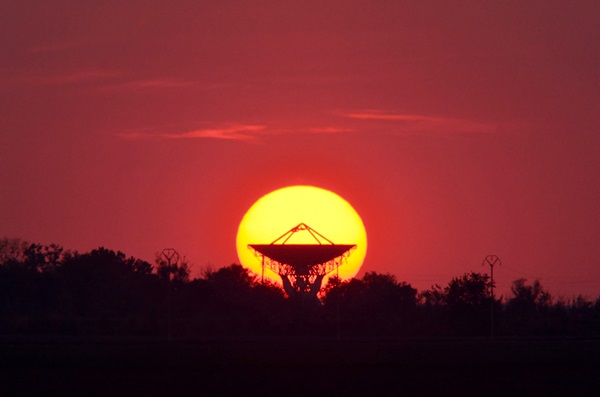The Sky This Week from August 23 to September 1 – Astronomy Magazine
The lazy, hazy days of August
The Sun sets behind the 32-meter radio dish at the Medicina Radio Observatory in Italy. The photographer captured the scene from approximately 2.5 miles (4 km) away — far enough that the antenna appeared slightly smaller than our star.
Fabrizio Melandri
Observers of the outer solar system can now get a good view of Uranus during the late evening hours. The ice giant planet rises shortly after 10 p.m. local daylight time and climbs 20° high in the east by midnight. It reaches its peak about 60° above the southern horizon around the start of morning twilight. Uranus glows at magnitude 5.7 against the backdrop of southern Aries the Ram. Use binoculars to find the planet 2.3° south-southeast of the similarly bright star 19 Arietis. A telescope reveals Uranus’ blue-green disk, which spans 3.6″.
Saturday, August 24
Look for the waning crescent Moon this morning as it hovers just east of the Hyades star cluster in Taurus the Bull. The two objects clear the horizon by 1 a.m. local daylight time and climb halfway to the zenith by the time morning twilight begins. The Moon appears about 40 percent lit and easily outshines the stars of the V-shaped Hyades. First-magnitude Aldebaran, which marks one tip of the V, appears brighter than the rest of the cluster’s stars because it actually lies in the foreground.
Sunday, August 25
Jupiter continues to dominate the evening sky from its perch in southern Ophiuchus the Serpent-bearer. The giant planet shines at magnitude –2.3 and stands some 25° high in the south-southwest as twilight fades to darkness. When viewed through a telescope, the planet shows a 40″-diameter disk and striking cloud-top detail. As a bonus, Jupiter currently appears near the edge of the 10th-magnitude globular star cluster NGC 6235. The planet’s slow eastward motion relative to the background stars carries it across the cluster’s southern perimeter from this evening through the 27th. Although the giant world’s brilliance renders NGC 6235 barely visible through most telescopes, imagers should be able to capture both.
Mars reaches the farthest point in its orbit around the Sun at 9 p.m. EDT. At this so-called aphelion, the Red Planet lies 154.9 million miles (249.2 million km) from our star. Mars is now lost in the solar glare, but it will return to view this fall to start an impressive apparition that will culminate in October 2020.
Monday, August 26
Asteroid 15 Eunomia reached opposition and peak visibility just two weeks ago, and it remains a tempting target. The main-belt object traverses the sky from dusk to dawn and climbs halfway to the zenith in the southern sky around midnight local daylight time. Eunomia shines at magnitude 8.4 and should be easy to find through binoculars under a dark sky and in a 4-inch telescope from the suburbs. The asteroid lies among the background stars of Aquarius the Water-bearer, some 7° west of magnitude 2.9 Beta (β) Aquarii. But 6th-magnitude 12 Aqr provides an even better guide. This evening, Eunomia slides 0.1° south of this star.
Tuesday, August 27
Distant Neptune reaches opposition and peak visibility one week from today, but the view now is essentially the same. The ice giant planet rises during evening twilight and climbs halfway to the zenith in the southern sky by 2 a.m. local daylight time. The magnitude 7.8 planet lies in Aquarius, just 0.25° east-northeast of 4th-magnitude Phi (φ) Aquarii. You’ll need binoculars to spy Neptune and a telescope to see its blue-gray disk, which spans 2.4″.





